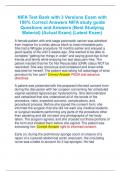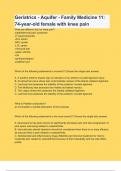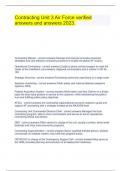NIFA Test Bank with 3 Versions Exam with
100% Correct Answers NIFA study guide
Questions and Answers (Best Studying
Material) (Actual Exam) (Latest Exam)
A female patient with end-stage pancreatic cancer was admitted
from hospice for a celiac plexus block to treat intractable pain.
She had a Whipple procedure 18 months earlier and enjoyed a
good quality of life until 3 weeks ago. She wanted to be able to
complete "getting her things in order" and saying good-bye to her
friends and family while enjoying her last days pain-free. The
patient insisted that her Do Not Resuscitate (DNR) status NOT be
rescinded. She was conscious and competent and knew what
was best for herself. The patient was taking full advantage of what
provision for her care? Correct Answer PSDA and advance
directives
A patient was presented with the prepared informed consent form
during the discussion with her surgeon concerning her scheduled
vaginal-assisted laparoscopic hysterectomy. She demonstrated
and verbalized that she understood all of the tenets of the
procedure, risks, expected outcome, complications, and
procedural process. Before she signed the consent form, she
informed the surgeon that she did not want any medical students
or surgical residents performing any parts of the procedure other
than assisting and did not want any photographs of her body
taken. The surgeon agreed, and she crossed out those portions of
the form and initialed them before she signed. The patient was
exercising her: Correct Answer right to informed consent.
Early on, during the preliminary sponge count on closure of a
repair of a ruptured abdominal aortic aneurysm, the circulating
nurse was unable to account for 2 lap sponges. He had
,meticulously maintained accountability for all sponges and
instruments discarded from the sterile field and bagged each
sponge carefully. He immediately turned and addressed the entire
team in a clear voice. Select the appropriate communication that
the circulating nurse must employ during this count discrepancy.
Correct Answer "We have a count discrepancy. We started with
70 sponges and find only 68. We are missing 2 lap sponges.
Everyone, please check your areas.
The OR is a danger-prone area for both patients and staff.
Providing a safe environment of care for the patient involves
identifying, mitigating, and managing the hazards inherent in
surgical care. Choose the answer below that completes the
blanks in this sentence: The risk of the surgical hazard of
_________________ can be mitigated through
_______________________. Correct Answer wrong patient,
wrong site, and wrong side surgery; site marking and presurgical
checklists
A patient was transferred to the postanesthesia care unit (PACU)
by the anesthesia provider and perioperative nurse. A hand-off
report was given, using situation, background, assessment,
recommendation (SBAR) format, to the accepting PACU nurse.
The first element of information that should be presented in the
hand-off report is: Correct Answer patient identification and
procedure performed.
If a staff person receives a needlestick injury, what is the first
corrective action? Correct Answer Wash wound with soap and
water; flush mucous membranes.
Contact with infected patients or infectious material places
healthcare workers at risk for occupational-acquired infection.
Which communicable disease are healthcare workers at risk for
acquiring or transmitting? Correct Answer Seasonal influenza
,Select the appropriate nursing action that supports hands-free
instrument passing and sharps safety. Correct Answer Create a
neutral hands-free area between the scrub person and surgeon
with a basin or magnetic mat.
Select the guideline that complements the design of the culture of
safety model. Correct Answer Incorporate safe practices into your
daily work when handling sharps.
A neutral zone is a predetermined location on the surgical field
where sharps are placed for retrieval by the surgeon. Which of the
following is a best practice for the use of the neutral zone?
Correct Answer Announce the transfer of each sharp before
placing it in the neutral zone.
Which of the following may be a consequence of high-dose or full-
body radiation? Correct Answer Nausea, vomiting, and diarrhea
Exposure to blood-borne pathogens occurs during all phases of
the perioperative process. Observing safety precautions during all
phases of surgery, from setup to cleanup, reduces the number of
injuries and exposures for all OR personnel. For the prevention of
sharps injuries in the pre-procedure and post-procedure phases,
which safe handling practices reflect appropriate nursing actions?
Correct Answer Use standardized sterile field setups throughout
the surgical service department.
Transport reusable sharps in a safe, closed container to the
decontamination cleanup area.
Do not place hands or fingers into a container to dispose of a
device.
, Inspect the sharps container for overfilling before discarding
disposable sharps in it.
Which list of medications best reflects medications indicated for
latex sensitivity therapeutic management? Correct Answer
Epinephrine, prednisone, and a beta-agonist inhaler
While antibiotics have been credited with saving lives, misuse of
antibiotics has contributed to the evolution of multidrug-resistant
organisms (MDROs). Select the antibiotic application that has
evident to support it as a best practice and not, potentially, a
misuse of antibiotics. Correct Answer Antibiotics given
intravenously within 1 hour of the incision for every procedure with
an incision or entered body system.
With the production of more steam in the sterilizer chamber, the
pressure increases as well. The steam should contain little or no
entrapped liquid water. Steam quality is the term that describes
the amount of water mixed with the steam. The constitution of
high-quality steam would be measured by: Correct Answer <3%
of the mixture is liquid water.
A 47-year-old man was admitted to the emergency department
(ED) with respiratory symptoms, facial and upper body abrasions,
burns, and moist lesions after a small package, delivered to his
office, exploded and sprayed him dried powder and glass shards.
In response to the reported mechanism of injury, the ED team
sequestered him in a secluded area away from the rest of the
patients. The team believed that this was highly suspicious of a
bio-terrorism event. The epidemiologist was called, and the
patient was transferred to a negative-pressure isolation room and
placed on standard, contact, airborne, and droplet precautions.
Based on these actions, which microorganism agents might be
suspected to be involved? Correct Answer Anthrax and smallpox






